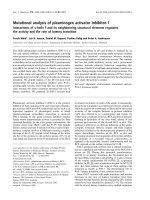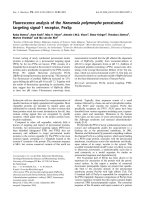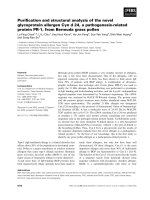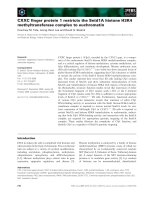STRUCTURE-FUNCTION ANALYSIS OF CXXC FINGER PROTEIN 1
Bạn đang xem bản rút gọn của tài liệu. Xem và tải ngay bản đầy đủ của tài liệu tại đây (11.13 MB, 301 trang )
STRUCTURE-FUNCTION ANALYSIS OF
CXXC FINGER PROTEIN 1
Courtney Marie Tate
Submitted to the faculty of the University Graduate School
in partial fulfillment of the requirements
for the degree
Doctor of Philosophy
in the Department of Biochemistry and Molecular Biology,
Indiana University
April 2009
ii
Accepted by the Faculty of Indiana University, in partial
fulfillment of the requirements for the degree of Doctor of Philosophy.
__________________________
David G. Skanik, Ph.D Chair
__________________________
Robert M. Bigsby, Ph.D.
Doctoral Committee
__________________________
Joseph R. Dynlacht, Ph.D.
February 19, 2009
__________________________
Ronald C. Wek, Ph.D.
iii
Acknowledgements
First, I would like to thank my advisor, Dr. David Skalnik, for his mentorship
throughout my graduate career. He has been an outstanding advisor, and I appreciate
his time, patience, and the guidance he has given me for my thesis project. I also
appreciate his advice and suggestions he has given for my future career.
I would like to express my gratitude to the members of my committee: Dr.
Joseph Dynlacht, Dr. Ronald Wek, and Dr. Robert Bigsby. I am grateful to all for their
time, guidance, and suggestions concerning my research project. I would also like to
thank Dr. Melissa L. Fishel for her help and collaboration with the DNA damage aspect
of my project. I am grateful to the NIH for three years of fellowship support for an
Infectious Disease Training Grant through Dr. Janice Blum. I would like to thank Dr.
Janice Blum for her interest in my project and for alerting me to conferences and
workshops to enhance my graduate studies. I would also like to thank Dr. Kristin Chun
for her advice with my projects and with improving my presentations. I am grateful to
the Deparment of Education for support my first year of graduate studies through a
GAANN (Graduate Assistance in Areas of National Need) fellowship.
I also need to acknowledge the past and present members of the Skalnik Lab, the
environment was an enjoyable place to carry out my research, and the interactions, both
scientific and personal, were crucial for my success at Indiana University. For this, I
am grateful to Dr. Jeong-Heon Lee, Dr. Suzanne Young, Dr. Jill Butler, Erika Dobrota,
Dr. Raji Muthukrishnan, and Patricia Pick-Franke. I would like to thank the lab
members for their friendship, support, advice, and help.
iv
Finally, I need to sincerely thank my family for their love, support, and
encouragement. I appreciate my parents, Jerry and Sherree, for ingraining a solid
foundation of hard work and dedication in me. My parents have provided me with
everything I have ever needed to be where I am today and have always been there for
me. Also, I want to thank my parents for believing in me and encouraging me to pursue
my dreams. I am grateful to know that I can always count on my family for help, and
comforted to know that I will always have their love and support. I would particularly
like to thank my grandparents (Mary and Ralph), my brothers (Ryan and Dustin), and
my aunts (Teta Jeannie and Teta Karen) for their love, support, and interest in my
project. I am grateful to Giancarlo for his love, support, colorful suggestions to explain
the unexpected results of some of my experiments, and patience with me while carrying
out my thesis research and writing. I would also like to thank the rest of my family,
Giancarlo’s family, and my friends for their support and encouraging me to relax, have
fun, and enjoy life. I am indebted to my family for their support and indispensable role
in my achievements, for this, I dedicate this work to them.
v
Abstract
Courtney Marie Tate
STRUCTURE-FUNCTION ANALYSIS OF CXXC FINGER PROTEIN 1
This dissertation describes structure-function studies of CXXC finger protein 1
(Cfp1), encoded by the CXXC1 gene, in order to determine the functional significance
of Cfp1 protein domains and properties. Cfp1 is an important regulator of chromatin
structure and is essential for mammalian development. Murine embryonic stem (ES)
cells lacking Cfp1 (CXXC1
-/-
) are viable but demonstrate a variety of defects, including
hypersensitivity to DNA damaging agents, reduced plating efficiency and growth,
decreased global and gene-specific cytosine methylation, failure to achieve in vitro
differentiation, aberrant histone methylation, and subnuclear mis-localization of
Setd1A, the catalytic component of a histone H3K4 methyltransferase complex, and tri-
methylated histone H3K4 (H3K4me3) with regions of heterochromatin. Expression of
wild-type Cfp1 in CXXC1
-/-
ES cells rescues the observed defects, thereby providing a
convenient method to assess structure-function relationships of Cfp1. Cfp1 cDNA
expression constructs were stably transfected into CXXC1
-/-
ES cells to evaluate the
ability of various Cfp1 fragments and mutations to rescue the CXXC1
-/-
ES cell
phenotype.
These experiments revealed that expression of either the amino half of Cfp1
(amino acids 1-367) or the carboxyl half of Cfp1 (amino acids 361-656) is sufficient to
rescue the hypersensitivity to DNA damaging agents, plating efficiency, cytosine and
histone methylation, and differentiation defects. These results reveal that Cfp1 contains
redundant functional domains for appropriate regulation of cytosine methylation,
vi
histone methylation, and in vitro differentiation. Additional studies revealed that a
point mutation (C169A) that abolishes DNA-binding activity of Cfp1 ablates the rescue
activity of the 1-367 fragment, and a point mutation (C375A) that abolishes the
interaction of Cfp1 with the Setd1A and Setd1B histone H3K4 methyltransferase
complexes ablates the rescue activity of the 361-656 Cfp1 fragment. In addition,
introduction of both point mutations (C169A and C375A) ablates the rescue activity of
the full-length Cfp1 protein. These results indicate that retention of either DNA-
binding or Setd1 association of Cfp1 is required to rescue hypersensitivity to DNA
damaging agents, plating efficiency, cytosine and histone methylation, and in vitro
differentiation. In contrast, confocal immunofluorescence analysis revealed that full-
length Cfp1 is required to restrict Setd1A and histone H3K4me3 to euchromatic
regions.
David G. Skalnik, Ph.D. - Chair
vii
Table of Contents
LIST OF TABLES xiv
LIST OF FIGURES xv
ABBREVIATIONS xx
FOCUS OF DISSERTATION xxiii
INTRODUCTION 1
I. Chromatin Structure and Epigenetics 1
II. Cytosine Methylation 5
II. DNA Methyltransferase Enzymes 8
III. Methyl CpG Binding Proteins 14
V. Heterochromatin 16
VI. Histone Modifications 17
VII. Histone Methylation 20
VIII. Histone Methylation and RNA Polymerase II 24
IX. ATP-dependent Chromatin Remodeling 26
X. Epigenetic Cross-talk 27
XI. Epigenetics and Disease 29
XII. Chromatin Structure and DNA Repair 33
XIII. DNA Base Excision Repair 38
XIV. Apurinic/Apyrimidinic Endonuclease (Ape1/Ref-1) 41
XV. CXXC Finger Protein 1 (Cfp1) 42
METHODS 53
I. Cell Culture 53
viii
II. Transient Transfection 53
III. Stable Transfection 54
IV. Construction of Plasmids 55
1. Construction of hCfp1 pcDNA3.1/Hygro constructs 55
2. Construction of hCfp1/pcDNA3-Myc and hDNMT1/
pcDNA3-FLAG constructs 58
V. Plasmid Purification and Transformation 58
1. Plasmid Transformation 58
2. Minipreps 59
3. Maxipreps 59
VI. Site-directed Mutagenesis 60
VI. Production of 6XHis-tagged Proteins and Electrophoretic
VII. Mobility Shift Assay 62
VIII. Isolation of Genomic DNA 63
IX. Analysis of Global Cytosine Methylation 64
X. Southern Blot Analysis 64
XI. Embryonic Stem Cell Differentiation 66
1. Morphological Analysis of Differentiation 66
2. Detection of Alkaline Phosphatase Activity 66
3. Reverse Transcriptase PCR (RT-PCR) for Analysis of Lineage
Markers 67
XII. RNA Isolation 70
XIII. Nuclear Extract Preparation 70
ix
XIV. Whole Cell Protein Extract Preparation 71
XV. Histone Protein Preparation 71
XVI. Subcellular Fractionation 72
XVII. Co-Immunoprecipitation 72
XVIII. Western Blot Analysis 73
XIX. Cell Growth Curves 74
XX. TUNEL Analysis 75
XXI. Cell Cycle Analysis 75
XXII. Sorting of Apoptotic Cells 76
XXIII. Colony Forming Assay 77
XXIV. Confocal Microscopy 77
XXV. Cell Cycle Synchronization 79
XXVI. Drug Treatments and Irradiation 79
XXVII. Ape1 Endonuclease Activity Assay 80
XXVIII. H2AX Phosphorylation Expression as a Measure of
DNA Damage 81
XXIX. Measurement of Total Platinum in DNA 82
XXX. Statistical Analysis 82
RESULTS 84
I. Protein Expression of Cfp1 Mutations and Verification of
Functional Domain Disruption 84
1. Isolation of CXXC1
-/-
ES clones expressing various Cfp1 mutations 84
x
2. Mutations that abolish DNA-binding activity or Setd1 association
of Cfp1 89
3. Additional Cfp1 mutations within the PHD domains 93
4. DNA-binding activity of Cfp1 is not required for interaction with
Dnmt1 94
5. Mutated forms of Cfp1 are associated with the nuclear matrix 94
6. Summary 98
II. Analysis of Cfp1 Functional Properties Required to Rescue Population
Doubling Time and Plating Efficiency 99
1. Analysis of population doubling time in CXXC1
-/-
ES cells
expressing Cfp1 mutations 99
2. CXXC1
-/-
ES cells exhibit normal cell cycle distribution 100
3. Apoptosis analysis in CXXC1
-/-
ES cells expressing Cfp1
mutations 104
4. Plating efficiency of CXXC1
-/-
ES cells expressing Cfp1 mutations . 107
5. Summary 111
III. Analysis of Cfp1 Functional Domains Required to Rescue Cytosine
Methylation and in vitro Differentiation 113
1. DNA-binding activity of Cfp1 is not essential for appropriate
global cytosine methylation 113
2. Increased apoptosis in CXXC1
-/-
ES cells is not responsible for the
observed decrease in global cytosine methylation 118
xi
3. Decreased cytosine methylation at IAP repetitive elements in
CXXC1
-/-
ES cells expressing Cfp1 mutations that exhibit
decreased global cytosine methylation 120
4. Decreased Dnmt1 protein expression in CXXC1
-/-
ES cells
expressing Cfp1 mutations that exhibit decreased global
cytosine methylation 125
5. CXXC1
-/-
ES cells expressing Cfp1 mutations that rescue cytosine
methylation can achieve in vitro differentiation 129
6. Summary 144
IV. Analysis of Cfp1 Functional Properties Required to Rescue
Histone Methylation 145
1. CXXC1
-/-
ES cells exhibit decreased Setd1A protein expression 145
2. DNA-binding activity of Cfp1 or association of Cfp1 with the Setd1
complexes is required to rescue Setd1A protein expression 149
3. CXXC1
-/-
ES cells exhibit altered histone methylation 154
4. Neither DNA-binding activity of Cfp1 nor association of Cfp1 with
the Setd1 complexes is required to rescue histone H3K9
methylation 156
5. Retention of either DNA-binding activity of Cfp1 or association of
Cfp1 with the Setd1 complexes is required to rescue histone
H3K4 methylation 159
6. Cfp1 is required to restrict subnuclear localization of Setd1A
protein and H3K4me3 to euchromatin 163
xii
7. Full-length Cfp1 is required to restrict the Setd1A histone
methyltransferase complex and H3K4me3 to euchromatin 168
8. Summary 176
V. Analysis of Cfp1 Function in DNA Damage Sensitivity 182
1. CXXC1
-/-
ES cells exhibit hypersensitivity to DNA damaging
agents 182
2. CXXC1
-/-
ES cells do not demonstrate hypersensitivity to non-
genotoxic agents 187
3. Expression of Cfp1 in CXXC1
-/-
ES cells rescues the hypersensitivity
to DNA damaging agents 188
4. Hypersensitivity of CXXC1
-/-
ES cells to DNA damaging agents is not
solely caused by decreased cytosine methylation 188
5. CXXC1
-/-
ES cells exhibit decreased Ape1 protein expression and
endonuclease activity 193
6. CXXC1
-/-
ES cell DNA exhibits increased incorporation
of platinum 199
7. CXXC1
-/-
ES cells demonstrate increased H2AX-γ formation upon
DNA damage 202
8. Redundant functional domains within the Cfp1 protein rescue
hypersensitivity to TMZ and cisplatin 204
9. Cfp1 DNA-binding activity or interaction with the Setd1 complexes
is required to rescue hypersensitivity to TMZ and cisplatin and
Ape1 protein expression 204
xiii
10. Decreased Ape1 protein expression in Cfp1 mutations that
exhibit hypersensitivity to DNA damaging agents 207
11. Summary 207
DISCUSSION 210
I. DNA-binding Activity of Cfp1 or Interaction with the Setd1
Complexes is Important for ES Cell Plating Efficiency, Cytosine
Methylation, Histone Methylation, In vitro Differentiation, and DNA
Damage Sensitivity 210
1. Cfp1 rescue activity for appropriate ES cell growth, apoptosis, and
plating efficiency 211
2. Cfp1 rescue activity for cytosine methylation and in vitro
differentiation 213
3. Cfp1 rescue activity for appropriate Setd1A protein expression
and histone methylation 221
4. Cfp1 contains redundant functional domains 222
II. Cfp1 DNA-binding Activity and Setd1 Interaction is Required to
Restrict the Setd1A Complex to Euchromatin 226
III. Cfp1 is Required for Appropriate DNA Damage Sensitivity and
Ape1 Protein Expression and Endonuclease Activity 228
IV. Future Directions 234
V. Summary 245
REFERENCES 247
CURRICULUM VITAE
xiv
List of Tables
TABLE 1. Oligonucleotides used to generate FLAG-Cfp1 mutation
constructs 61
TABLE 2. Oligonucleotides used for amplification of IAP probe for cytosine
methylation analysis by Southern blot 66
TABLE 3. Primers and annealing temperatures used for analysis of
developmental and lineage specific markers during in vitro
differentiation 69
TABLE 4. Summary of Cfp1 subcellular localization data 97
TABLE 5. Summary of population doubling time, apoptosis, and plating
efficiency rescue activity 112
TABLE 6. Summary of global cytosine methylation, IAP cytosine
methylation, and Dnmt1 protein expression rescue activity 143
TABLE 7. Summary of Setd1A and histone methylation data 178
TABLE 8. Summary of Cfp1 full-length clone data 179
TABLE 9. Summary of Cfp1 truncation clone data 181
TABLE 10. Summary of TMZ and cisplatin sensitivity and Ape1 protein
expression rescue activity 209
xv
List of Figures
FIGURE 1. Chromatin classification 3
FIGURE 2. Sites of covalent modifications in histone N-termini 19
FIGURE 3. Cfp1 protein domains 44
FIGURE 4. Cfp1 protein alignment between species 46
FIGURE 5. Expression constructs generated for stable expression of hCfp1
and hCfp1 mutations 57
FIGURE 6. Cfp1 fragments and mutations 85
FIGURE 7. Protein expression of Cfp1 fragments and mutations 87
FIGURE 8. Mutations in the CXXC and SID domains of Cfp1 that abolish
DNA-binding activity of Cfp1 or interaction of Cfp1 with the
Setd1 complexes 91
FIGURE 9. Ablation of Cfp1 DNA-binding activity does not affect Cfp1
interaction with Dnmt1 95
FIGURE 10. Cfp1 is associated with the nuclear matrix 96
FIGURE 11. Doubling time of CXXC1
-/-
ES cells expressing Cfp1 mutations 102
FIGURE 12. CXXC1
-/-
ES cells exhibit normal cell cycle distribution 103
FIGURE 13. Apoptosis analysis in CXXC1
-/-
ES cells expressing Cfp1
mutations 106
FIGURE 14. Plating efficiency in CXXC1
-/-
ES cells expressing Cfp1
mutations 109
FIGURE 15. Cfp1 has redundancy of function for rescue of global cytosine
methylation 114
xvi
List of Figures (cont)
FIGURE 16. DNA-binding activity of Cfp1 or interaction with the Setd1
histone methyltransferase complexes is required for appropriate
cytosine methylation 117
FIGURE 17. Healthy CXXC1
-/-
ES cells exhibit decreased global cytosine
methylation 119
FIGURE 18. Cfp1 has redundancy of function for cytosine methylation of
repetitive elements 121
FIGURE 19. DNA-binding activity of Cfp1 or interaction with the Setd1
histone methyltransferase complexes is important for cytosine
methylation of repetitive elements 122
FIGURE 20. IAP cytosine methylation in CXXC1
-/-
ES cells expressing
additional Cfp1 mutations 123
FIGURE 21. Cfp1 has redundancy of function for appropriate Dnmt1
protein expression 126
FIGURE 22. DNA-binding activity of Cfp1 or interaction with the Setd1
histone methyltransferase complexes is important for appropriate
Dnmt1 protein expression 127
FIGURE 23. Dnmt1 protein expression in CXXC1
-/-
ES cells expressing
additional Cfp1 mutations 128
FIGURE 24. Cfp1 has redundancy of function for in vitro differentiation 130
xvii
List of Figures (cont)
FIGURE 25. CXXC1
-/-
ES cells expressing Cfp1 mutations that exhibit
appropriate global cytosine methylation achieve in vitro
differentiation 132
FIGURE 26. Analysis of in vitro differentiation in CXXC1
-/-
ES cells
expressing additional Cfp1 mutations 135
FIGURE 27. CXXC1
-/-
ES cells expressing Cfp1 fragments induce expression
of lineage and developmental markers upon in vitro
differentiation 137
FIGURE 28. CXXC1
-/-
ES cells expressing Cfp1 mutations that morphologically
exhibit an outgrowth induce expression of lineage and
developmental markers 138
FIGURE 29. CXXC1
-/-
ES cells expressing Cfp1 mutations that morphologically
exhibit an outgrowth induce expression of lineage and
developmental markers 141
FIGURE 30. Cfp1 is required for appropriate expression of Setd1A and
Setd1B 146
FIGURE 31. Cfp1 has redundancy of function for appropriate protein
expression of Setd1A 150
FIGURE 32. DNA binding activity of Cfp1 or association of Cfp1 with the
Setd1 complexes is required for appropriate protein expression
of Setd1A 152
xviii
List of Figures (cont)
FIGURE 33. Cfp1 is required for appropriate levels of H3K9me2 and
H3K4me3 155
FIGURE 34. Cfp1 has redundancy in function for appropriate levels of
H3K9me2 157
FIGURE 35. Neither DNA binding activity of Cfp1 nor association of Cfp1
with the Setd1 complexes is required for appropriate global
levels of H3K9me2 158
FIGURE 36. Cfp1 has redundancy in function for appropriate levels of
H3K4me3 160
FIGURE 37. DNA-binding activity of Cfp1 or association of Cfp1 with the
Setd1 complexes is required for appropriate global levels of
H3K4me3 161
FIGURE 38. Cfp1 is required to restrict Setd1A subnuclear localization to
euchromatin 164
FIGURE 39. Cfp1 is required to restrict H3K4me3 subnuclear localization to
euchromatin 165
FIGURE 40. Changes in distribution of CXXC1
-/-
ES cells within the cell cycle
does not affect the magnitute of mis-localization of H3K4me3
with DAPI-bright heterochromatin 167
FIGURE 41. Full-length Cfp1 is required to restrict Setd1A protein subnuclear
localization to euchromatin 170
xix
List of Figures (cont)
FIGURE 42. Full-length Cfp1 is required to restrict H3K4me3 subnuclear
localization to euchromatin 173
FIGURE 43. Full-length Cfp1 is required to restrict H3K4me3 subnuclear
localization to euchromatin 175
FIGURE 44. Sensitivity of CXXC1
+/+
and CXXC1
-/-
ES cells to DNA
damaging agents 184
FIGURE 45. Sensitivity of CXXC1
+/+
and CXXC1
-/-
ES cells to non-genotoxic
agents 186
FIGURE 46. Sensitivity of CXXC1
+/+
, CXXC1
-/-
, and CXXC1
-/cDNA
ES cells to
DNA damaging agents 189
FIGURE 47. DNA damaging agent sensitivity in CXXC1
+/+
, CXXC1
-/-
, and
DNMT1
-/-
ES cells 191
FIGURE 48. Sensitivity of CXXC1
+/+
, CXXC1
-/-
, CXXC1
-/cDNA
, and
DNMT1
-/-
ES cells to non-genotoxic agents 192
FIGURE 49. Ape1 protein expression and endonuclease activity in CXXC1
+/+
,
CXXC1
-/-
, and DNMT1
-/-
ES cells 194
FIGURE 50. Ape1 does not interact with Cfp1 197
FIGURE 51. Ape1 is distributed throughout the nucleus and cytoplasm in
ES cells 198
FIGURE 52. CXXC1
-/-
ES cells accumulate increased DNA damage 201
FIGURE 53. Redundant functional domains within the Cfp1 protein rescue
hypersensitivity to TMZ and cisplatin 203
xx
List of Figures (cont)
FIGURE 54. DNA-binding activity of Cfp1 or interaction with the Setd1
complexes is required to rescue DNA damage hypersensitivity 205
FIGURE 55. Ape1 protein expression in CXXC1
-/-
ES cells expressing
Cfp1 mutations 206
FIGURE 56. Model for Cfp1 redundant function 224
xxi
Abbreviations
A alanine
AP apurinic/apyrimidinic
bp base pairs
BER base excision repair
C cysteine
cDNA complementary DNA
Cfp1 CXXC finger protein 1
cpm counts per minute
DAPI 4’,6-diamidino-2-phenylindole
ddH
2
0 double distilled water
DEPC diethyl pyrocarbonate
DNA deoxyribonucleic acid
DNMT DNA methyltransferase
dpc days post coitum
DTT dithiothreitol
E embryonic
EDTA ethylenediaminetetraacetic acid
ES embryonic stem
EtOH Ethanol
g gram (s)
H histone
h hours (s)
xxii
Abbreviations (cont)
HAT histone acetyltransferase
HDAC histone deacetylase
HEK human embryonic kidney
HEPES N-2-hydroxyethylpiperazine-N’-2-ethanesulfonic acid
HMT histone methyltransferase
HYG hygromycin
ICM intermediate cell mass
K Lysine
LB broth Luria-Bertani broth
LIF leukemia inhibitory factor
M molar, moles per liter
mM millimolar
MBD methyl-CpG binding domain
µ micro
me methylated
MeOH methanol
min minute (s)
ml milliliter
MOPS [3-(N-Morpholino)Propane Sulfonic Acid]
mRNA messenger ribonucleic acid
NaCl sodium chloride
NLS nuclear localization signal
xxiii
Abbreviations (cont)
PAGE polyacrylamide gel electrophoresis
PBS phosphate buffered saline
PCR polymerase chain reaction
PHD plant homology domain
PMSF phenylmehtylsulfonyl fluoride
RNA ribonucleic acid
RNAPII RNA polymerase II
RNase ribonuclease
RPM revolutions per minute
RT-PCR reverse transcriptase polymerase chain reaction
S serine
SAM S-adenosyl-L-methionine
SDS sodium dodecyl sulfate
sec second (s)
SET Suppressor of Variegation, Enhancer of Zeste and Trithorax
SID Set1 interaction domain
TBS Tris-buffered saline
TBS-T Tris-buffered saline-Tween 20
TBE Tris-Borate-EDTA
V Volts
x g centrifugal force, gravity
Y tyrosine
xxiv
Focus of Dissertation
The first portion of this dissertation is a determination of the importance of Cfp1
protein domains and properties in mediating Cfp1 function in ES cell growth, colony
forming ability, cytosine methylation, and differentiation. This was achieved by
expressing various Cfp1 mutations in CXXC1
-/-
ES cells and assaying for rescue of the
defects observed in the absence of Cfp1. Colony forming assay was used to analyze
plating efficiency, cell growth curves were used to calculate cell population doubling
time, and apoptosis was analyzed by TUNEL assay in CXXC1
-/-
ES cells expressing
Cfp1 mutations. Global cytosine methylation was analyzed by methyl acceptance
assay, Southern blot was used to analyze gene-specific cytosine methylation at IAP
repetitive elements, and Western blot was used to analyze Dnmt1 protein expression
levels in CXXC1
-/-
ES cells expressing Cfp1 mutations. The ability of CXXC1
-/-
ES cells
expressing Cfp1 mutations to achieve in vitro differentiation was analyzed by
morphology, alkaline phosphatase activity, and RT-PCR (reverse transcriptase-
polymerase chain reaction) to assess induction of lineage and developmental markers.
The second portion of this dissertation focuses on the functional properties of
Cfp1 required to rescue the histone methylation defects observed in CXXC1
-/-
ES cells.
Western blot analysis was used to determine Setd1A protein expression and global
levels of H3K9me2 and H3K4me3 in CXXC1
-/-
ES cells expressing Cfp1 mutations.
Confocal immunofluorescence was carried out to determine subnuclear localization of
Setd1A and H3K4Me3 in CXXC1
-/-
ES cells expressing Cfp1 mutations.
The third portion of this dissertation focuses on gaining insight into the role that
chromatin structure plays in DNA damage sensitivity. Analysis of cell sensitivity to a
xxv
variety of DNA-damaging agents was determined in the absence of Cfp1 by clonogenic
survival assays. DNA damage accumulation was analyzed by accumulation of H2AX-γ
by Western blot analysis and platinum incorporation onto DNA by atomic absorption
spectroscopy. In addition, Western blot analysis was used to analyze Ape1 protein
expression, and Ape1 AP endonuclease activity was measured in CXXC1
-/-
ES cells.
This work demonstrated a novel finding that Cfp1 may play a role in the DNA repair
process.
The goal of this dissertation is to gain insight into the molecular mechanism of
how cytosine methylation and histone methylation are regulated in mammals. A current
focus in the field of epigenetic regulation is to understand how epigenetic machinery is
regulated and targeted within the genome. Describing the mechanism by which Cfp1
functional properties are required for appropriate regulation of chromatin structure and
targeting the Setd1A histone H3K4 methyltransferase complex contributes to the
understanding of epigenetic regulation. In addition, insight into the role that chromatin
structure plays in DNA-damaging agent and chemotherapeutic agent effectiveness may
lead to more effective combinations of chemotherapy in cancer patients.









